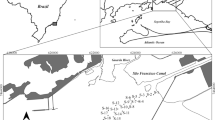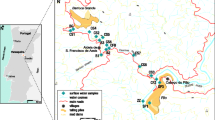Abstract
The given work focused on solving the problem of environmental geochemistry related to investigation of element speciation, their mobility, and migration in polluted areas. The purpose was to describe quantitatively migration, distribution, and redistribution of heavy metals by the example of the old tailings (Talmovaya sands) of the Lead Zinc Concentration Plant (Salair, Kemerovo region, Russia) and technogenic bottom sediments of the Malaya Talmovaya river. Contents of elements in the sulfide tailings range in the following limits: Zn: 1,100–27,000 ppm, Cd: 1.3–240 ppm, Pb: 0.01–0.81 ppm, Cu: 220–960 ppm, As: 15–970 ppm, Fe: 19,000–76,000 ppm, and Ba: 80,000–1,00,000 ppm. Element concentrations in the river sediment are proportional to the element contents in the sulfide tailings. Element speciations in the sulfide tailings and technogenic bottom sediments were investigated by the modified sequential extraction procedure. Chemical forms of heavy metals in pore water and surface water were calculated by WATEQ4F software. Principles of heavy metal migration in the sulfide tailings and technogenic bottom deposits were established. The obtained results about element species in the sulfide tailings and sediment explain the main principles of element migration and redeposition. In the mine waste and technogenic bottom deposits, there is vertical substance transformation with formation of geochemical barriers.






Similar content being viewed by others
References
Ball JW, Nordstrom DK (1991) User’s manual for WATERQ4F, with revised thermodynamic date base and rest cases for calculating speciation of major, trace, and redox elements in natural waters. Menlo Park, California
Blair RD, Cherry JA, Lim TP, Vivyurka AJ (1980) Groundwater monitoring and contaminant occurrence at an abandoned tailings area, Eliot Lake, Ontario. In: Proceedings of 1st international conference on uranium mine waste disposal, pp 911–944
Blowes DW, Jambor JL (1990a) The pore-water geochemistry and the mineralogy of the vadose zone of sulfide tailings, Waite Amulet, Quebec, Canada. Appl Geochem 5:327–346
Blowes DW, Jambor JL (1990b) The importance of cemented layers in inactive sulfide mine tailings. Geochem Cosmochem Acta 55:965–978
Bogush AA, Androsova NV (2007) Ecogeochemical state of the S. Talmovaya—Talmovaya—S. Bachat–Bachat—Inya river system (Kemerovo region). Ecol Industrial Product 1:8–16
Bogush AA, Trofimov AN (2005) Application of peat-humic substances for reduction of man-caused influence of mine wastes on environment. Chem Industry 82:153–158
Bogush AA, Voronin VG (2010) Application of a peat-humic agent for treatment of acid mine drainage. Mine Water Environ. doi:10.1007/s10230-010-0132-2
Bogush AA, Letov SV, Miroshnichenko LV (2007) Distribution and speciation of heavy metals in drainage water and sludge pond of the Belovo zinc plant (Kemerovo region). Geoecology 5:413–420
Bogush AA, Voronin VG, Galkova OG, Ishuk NV (2010) Application of natural and modified materials for treatment of acid mine drainage. In: Proceedings of the 1st international water quality conference, 23–24 June 2010, Leeds, UK, pp 24–27
Bolgov GP (1937) Sulfides of Salair. Urskaya group of polymetallic deposits. Tomsk industrial institute, Tomsk
Borman RS, Watson DM (1976) Chemical processes in abounded sulfide tailings dumps and environmental implication for Northeastern New Brunswick. Can Inst Min Metall Bull 69:86–96
Bortnikova SB (1989) Mineralogical and geochemical regularities of gold deposits in polymetallic ore belt of northeast Salair. Dissertation, United Institute of Geology, Geophysics and Mineralogy of Russian Academy of Science, Novosibirsk, Russia
De Vos KJ, Blowes DW, Robertson WD, Greenhouse JP (1995) Delineation and evaluation of a plume of tailings derived water, copper cliff, Ontario. In: Proceedings at Sudbury’95 conference vol 2, pp 673–682
Dold B (2003) Speciation of the most soluble phases in a sequential extraction procedure adapted for geochemical studies of copper sulfide mine waste. J Geochem Explor 80:55–68
Fanfani L, Zuddas P, Chessa A (1997) Heavy metals speciation analysis as a tool for studying mine tailings weathering. J Geochem Explor 58:241–248
Gupta G, Karuppiah M (1996) Heavy metals in sediments of two Chesapeake Bay tributaries Wicomico and Pocomoke rivers. J Hazard Mater 50:15–29
Hakansson K, Karlsson S, Allard BA (1989) Affects of pH on the accumulation and redistribution of metals in polluted stream bed sediment. Sci Total Environ 87(88):43–57
Jambor JL, Blowes DW (2003) Ritchie AIM Environmental Aspects of Mine Wastes. Mineral Assoc Can Short Course Ser 31:430
Labazin GS (1940) Structural and morphological features of polymetallic deposits of Salair mines and geological conditions of their finding. Non-ferrous Metals 3:14–20
Lapuhov AS (1975) Zoning of sulfur-polymetallic deposits. Nauka, Novosibirsk, Russia
Lottermoser BG (2007) Mine wastes: characterization, treatment and environmental impacts. Springer, Berlin
Maher WA (1984) Evaluation of a sequential extraction scheme to study association of trace elements in estuarine and oceanic sediments. Bull Environ Contam Toxicol 32:339–344
McGregor RG, Blowes DW (2002) The physical, chemical and mineralogical properties of three cemented layers within sulfide-bearing mine tailings. J Geochem Explor 76:195–207
Moore JV, Ramamurti S (1987) Heavy metals in natural waters. Mir, Moscow
Panin MS (2002) Chemical ecology. Semipalatinsk, Kazakhstan
Papina TS (1999) Transportation and features of distribution of heavy metals in water—suspended matter—bottom sediment of river ecosystem. IWEP SB RAS, Novosibirsk, Russia
Ribet I, Ptacek CJ, Blowes DW, Jambor JL (1995) The potential for metal release by reductive dissolution of weathered mine tailings. J Contam Hydrol 17:239–273
Routh J (1985) Chemical analysis and geochemical modeling of heavy metals in waters and sediments from Van Stone mine. Washington, USA
Salomon W, Forstner U (1984) Metals in hydrosphere. Springer, Berlin
Seal RR, Hammarstrom JM (2003) Geoenvironmental models of mineral deposits: examples from massive sulfide. Environ Aspects Mine Wastes 31:11–50
Sondag F (1981) Selective extraction procedures applied to geochemical prospecting in an area contaminated by old mine workings. J Geochem Explor 15:645–652
Task FM, Callewart OW, Verloo MG (1996) Metal solubility as a function of pH in a contaminated, dredged sediment affected by oxidation. Environ Pollut 2:199–208
Tessier A, Cambell PG, Bisson M (1979) Sequential extraction procedure for the speciation of particulate trace metals. Anal Chem 51:844–851
Tsareva SA, Chesnokova TA, Grinevich VI, Kostrov VV (1999) Metal speciation in water and bottom deposits of the Uvodsky reservoir. Water Resour 1:71–75
Williams RE (1975) Waste production and disposal in mining, milling and metallurgical industries. Miller Freeman Publications, San Francisco
Zyrina NG (1985) Chemistry of heavy metals, arsenic and molybdenum in soils. Publishing house of the Moscow University, Moscow
Acknowledgments
Special thanks are due to an anonymous reviewer for comments, questions and constructive review. This research was financially supported by the Russian Foundation for Basic Research (grant 03-05-64529 and 06-05-65007) and the interdisciplinary project of Siberian Branch of Russian Academy of Sciences (31).
Author information
Authors and Affiliations
Corresponding author
Rights and permissions
About this article
Cite this article
Bogush, A.A., Lazareva, E.V. Behavior of heavy metals in sulfide mine tailings and bottom sediment (Salair, Kemerovo region, Russia). Environ Earth Sci 64, 1293–1302 (2011). https://doi.org/10.1007/s12665-011-0947-6
Received:
Accepted:
Published:
Issue Date:
DOI: https://doi.org/10.1007/s12665-011-0947-6




